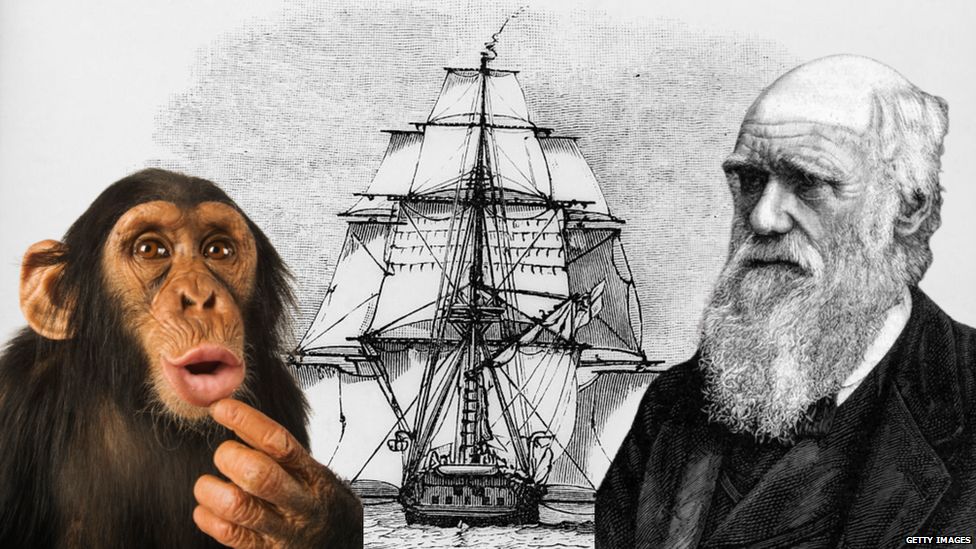Charles Darwin Day: Who was he and why is he famous?
- Published
- comments

You've likely heard the name Charles Darwin at some point.
But have you ever wondered what made him famous enough to get multiple statues made of him, to have a collection on his work in the Natural History Museum in London, and to have had his face on the ten pound note?
It was no biggie really - he just wrote books that changed people's understanding of the entire world and everything that lives in it.
He was one of the first people to popularise the theory of evolution - the scientific school of thought that says living things (including humans) change over time, in order to survive in their environment better.
If you love science, check these out
This is an illustration roughly showing what the evolution of humans could have looked like
Although not entirely new, it was a radical idea at the time, as some religious leaders said it went against a number of teachings about God.
But these days, his work on the theory of evolution is praised as some of the most important scientific research in history.
To find more about the man who told the world humans share distant relatives with monkeys, keep reading!
What was Charles Darwin's early life like?
Sir David Attenborough with the statue of Charles Darwin at the National history Museum
Charles Darwin was born into a very rich family in Shropshire on 12 February 1809, and was the fifth of six children.
Both his grandfathers had a really big influence on Charles. They were both important figures in a period of history called the Enlightenment, which was a time in Europe when lots of advances in art, politics and science were made.
One of his grandpas was Josiah Wedgewood, who campaigned to end slavery. The other was Erasmus Darwin, a doctor who wrote a book called 'Zoonomia'.
This book discussed a very controversial idea - transmutation, an early version of the theory that would become known as evolution.
What is evolution?
If you cannot see the quiz, click here.
While species of any animal or plant will have loads in common, none of them will be exactly the same.
For example, polar bears are built to live in cold climates because they all have lots of fat to keep them warm, and white fur that helps them hide in the snow.
But they'll have differences too - some might be faster than others, or better hunters. The faster polar bears would be more likely to survive, and so more likely to be able to live long enough to have cubs.
Want to learn more about evolution?
Although there will be many like it, no other polar bear will be exactly the same as this one
After inheriting those traits, the cubs would be even better at those things than their parents.
And that's evolution - put simply, it's the way that living things change and adapt over time, and this was the theory that Charles Darwin eventually dedicated his life to writing about.
How did Charles Darwin come up with the idea?
An artist's illustration of HMS Beagle
Charles tried a lot of things in his life, such as training to be a doctor at Edinburgh University, and then studying religion at Cambridge.
But his real passion was for biology - he absolutely loved collecting beetles. After graduating he was offered the chance of a lifetime: to travel round the world on a ship called the HMS Beagle.
Want to learn more about the animal kingdom? Play these games on BBC Bitesize
On this trip, he studied animals from across the globe, and read lots of books about them too.
One place he travelled to was the Galapágos, a group of volcanic islands with lots of interesting animals. There, and on other parts of his journey, he carefully observed animals and plants, and wrote up his theories of evolution.
Charles Darwin studied finches, mockingbirds and tortoises like this one while on the Galapágos islands
One animal he studied a lot was the finch - some were better at eating seeds, and some had a knack for catching insects, but all of them descended from the same type of finch. As they'd flown to different islands, they'd adapted to better suit the environment they made home.
Charles was very conflicted about his discoveries. He was a Christian, but some of his ideas went against traditional Christian teachings. So even though he wrote all of his theories down as he travelled, he didn't publish them for a long time.
It wasn't until November 1989 that he finally released his book, 'On the Origin of Species by Means of Natural Selection'. It received a lot of criticism from the Church and from newspapers when it came out, something that Charles was incredibly worried about happening.
In particular, people were shocked by the idea that humans shared a common ancestor (so evolved from the same distant relative) as apes. He didn't refer to it too much in his first book, knowing it would cause a stir, but went on to write more about it in later years.
Chimpanzees (on the left) and bonobos (on the right) are human's closest living relatives
As time went on though, people started paying lots of attention to Charles Darwin's theory of evolution, and he carried on adding to and strengthening it.
One phrase you may have heard before is 'survival of the fittest', which is a short way of explaining his idea that he came up with a few years after publishing his first book.
Now, Charles Darwin is regarded as one of the most influential scientists to have ever lived.
